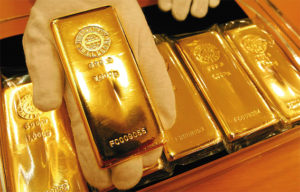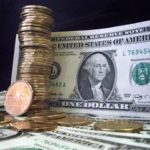 Gold advanced in a cautious trade on Wednesday as investors awaited the outcome of the FOMC meeting and potential news on Fed’s tapering timeline. Assets in the SPDR Gold Trust, the biggest bullion-backed ETF, were further reduced and remained at the lowest since January 2009, adding to bearish sentiment. A stronger US dollar pressured the yellow metal further.
Gold advanced in a cautious trade on Wednesday as investors awaited the outcome of the FOMC meeting and potential news on Fed’s tapering timeline. Assets in the SPDR Gold Trust, the biggest bullion-backed ETF, were further reduced and remained at the lowest since January 2009, adding to bearish sentiment. A stronger US dollar pressured the yellow metal further.
On the Comex division of the New York Mercantile Exchange, gold futures for settlement in February rose by 0.17% to trade at $1 232.20 per troy ounce by 12:24 GMT. Prices swung between day’s high and low of $1 236.60 and $1 228.10 an ounce respectively. The precious metal settled last week 0.8% higher. Prices touched $1 211.10 per troy ounce on December 4th, the lowest since July 5th, and closed the week 1.8% lower. Last month, gold plunged 5.5 percent, the most since June and the biggest drop in November since 1978.
The precious metal has fallen 26% so far this year and is heading for the first annual drop in 13 years as investors lost faith in it as a store of value amid a rally in U.S. equities to a record and muted inflation.
“The Fed is the big one this week, the market seems pretty split between whether they’ll start tapering in December, January or March. That’s keeping gold investors on their toes.”, said Victor Thianpiriya, an analyst at Australia & New Zealand Banking Group Ltd., cited by Bloomberg.
Fed stimulus outlook
The Federal Open Market Committee concludes a two-day meeting later today, which has kept investors cautious in the past days and avoided locking in big positions. Although a recent series of upbeat US data, including retail sales, industrial production, unemployment and third quarter growth, raised bets the Federal Reserve might trim its monthly bond purchases in December, the majority of economists haven’t shifted their expectations that the central bank will most likely wait until March.
Also supporting that view, the Department of Labor reported yesterday that consumer inflation in the US remained benign and well below Fed’s official target of 2%, leaving enough spare room for easy money supply. The consumer price index (CPI) rose 1.2% in November, compared to a year ago, short of analysts’ estimates of a 1.3% increase. In October, consumer prices jumped by 1.0%. Month-on-month, consumer inflation was flat, compared to October’s 0.1% decline and short of analysts’ projections of an increase by 0.1%.
Consumer prices, excluding food and energy costs, or core consumer prices, increased 1.7% in November from a year ago, the same as in October and in line with expectations. Month-on-month, Core CPI rose by 0.2% in November from 0.1% in October. Analysts’ forecasts pointed to a 0.1% gain. The Federal Reserve regards that core prices can be a better gauge of longer-term inflationary pressure, because they exclude the volatile food and energy categories.
The Federal Reserve may begin to scale back its $85 billion in monthly asset purchases at the committee’s policy meeting on December 17th-18th rather than wait until January or March, according to 34% of economists who participated in a Bloomberg survey on December 6th. In November’s survey, 17% of respondents projected a tapering in December.
Fed Reserve Bank of Atlanta President Dennis Lockhart said that any decision to taper should be accompanied by a limit on the size of the program or a timetable for ending it.
A stronger dollar put some pressure on the metal. The U.S. dollar index, which measures the greenback’s performance against a basket of six major peers, added 0.06% to trade at 80.26 by 12:22 GMT. The March contract held in a day’s range between 80.28 and 80.16. The U.S dollar index settled last week 0.06% lower, after declining 0.53% in the preceding two 5-day periods. Strengthening of the dollar makes commodities priced in it more expensive for foreign currency holders and limits their appeal as an alternative investment.
Assets in the SPDR Gold Trust, the biggest bullion-backed ETF, were reduced to 816.82 tons on Tuesday, the lowest since January 2009. The fund has not seen inflows in more than a month, hinting that a substantial increase in prices is unlikely.
Outflows have totaled nearly 488 tons this year. Billionaire hedge-fund manager John Paulson who holds the biggest stake in the SPDR Gold Trust told clients on November 20 that he wouldn’t invest more money in his gold fund because it isn’t clear when inflation will accelerate. US inflation is still well below the Fed target of 2.00%.





